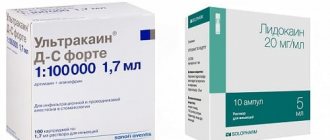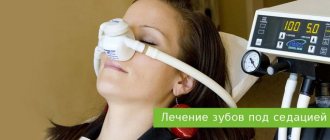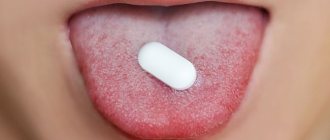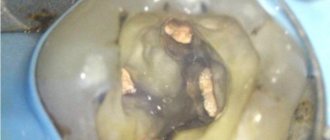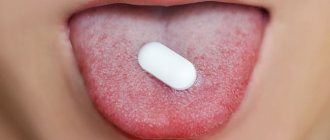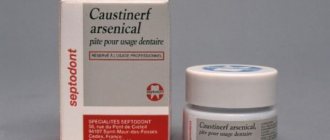Anesthesia during tooth extraction helps eliminate pain and normalize the patient’s psychological state. The variability of techniques makes it possible to select the optimal type of pain relief, taking into account the age, duration and traumatic nature of treatment, and the physical and mental state of the patient. When removing teeth, surface, infiltration and conduction anesthesia is used, and general anesthesia is used if indicated.
Types of anesthesia in dentistry
Anesthesia in dentistry can be general or local. The first includes intravenous sedation, as well as general anesthesia. That is, the drugs do not act locally in the oral cavity, but throughout the entire body. Actually, this is ordinary general anesthesia, which is used everywhere in medicine - it’s just that certain types are used in dentistry. Local, as it is already becoming clear, includes the familiar “freezing”, which is administered by injection.
Separately, we can also distinguish xenon sedation or xenon therapy - the second name will be even more correct, since such anesthesia is used to prepare for local or general anesthesia. It allows you to reduce the level of anxiety and stress, saturates the body's cells with oxygen, due to which it has a general healing and even rejuvenating effect! It is not an independent type of pain relief, but is used in combination with other approaches.
Medicines you shouldn't take
Many people use homemade medications for pain relief.
But they have low efficiency and can provoke undesirable results:
- Aspirin. The medicine is intended to perform an antipyretic function. The analgesic effect is minimal. Aspirin is a good blood thinner. This may lead to delayed bleeding. Although this medicine is included in many painkillers.
- Paracetamol. The drug can only cope with mild headaches. It has no anti-inflammatory effect and has a negative effect on the liver. Included in painkillers as an adjuvant.
- No-shpa. Many people think that this medicine is a pain reliever. But that's not true. No-spa is an antispasmodic drug that only eliminates pain associated with spasms. The pain after tooth extraction is completely different and no-spa will not be able to cope with it.
Xenon sedation or xenon therapy to prepare for main anesthesia
This is a separate type of anesthesia that can be used in combination with both local and general anesthesia (if necessary). Xenon is an inert gas that quickly begins to act and is just as quickly eliminated from the body. It has a relaxing effect: anxiety decreases, the patient relaxes. Moreover, during the operation he is fully conscious, can communicate with the doctor, and understands everything that is happening around him. The procedure can be interrupted if necessary if there is discomfort. At the same time, local anesthetics are used, since xenon itself does not have a pronounced analgesic effect.
Among the pleasant “bonuses” are saturation of cells with oxygen and restoration of metabolic processes. That is, this is not only a reduction in stress, but also a general improvement in the body’s health.
Easy removal
When nothing prevents you from removing the tooth from the socket and cutting the gums with a scalpel is not required, then such removal is considered simple. The procedure is carried out in the following order:
- the doctor orders an x-ray or recommends a CT scan;
- the problem area is numbed with local anesthetics;
- Using forceps, the surgeon first rocks the tooth and then pulls it out of the socket.
After the tooth is removed, the hole is treated with an antiseptic solution, after which a sterile swab is applied to it. If necessary, the wound is sutured. The entire procedure lasts about 10 minutes.
General anesthesia in dentistry
With general anesthesia, the patient falls asleep for 1-2 hours or more, i.e. for the entire duration of treatment. The drug is administered intravenously, less often by inhalation. If possible, general anesthesia should still be avoided, since its effect on many organs is quite toxic. Even despite the fact that dentistry uses “lighter” drugs than during complex surgical operations. This is a fairly large load on the body, especially on the heart, nervous and cardiovascular systems.
Intravenous sedation
Intravenous sedation does not have such pronounced negative consequences for the body. Softer and gentler drugs are used here. Sedation puts a person into a half-asleep state - the patient can respond to the doctor’s commands, communicate and understand him. At the same time, the person is completely relaxed and may even fall asleep for several hours. Thus, intravenous sedation is a more gentle and safe type of pain relief.
This is interesting! The word “sedation” itself means “calming.” It can be carried out either by inhalation (nitrous oxide or safer and more effective xenon is used for this), as well as intravenously with the selection of drugs strictly individually.
We treat without pain and discomfort!
Intravenous sedation
Safe and pain-free Treatment in your sleep Quick recovery from RUB 8,000. from 8,000 rub.
Xenon sedation
Relaxation before treatment No stress on the body Recovery in 2-3 minutes from RUB 5,000. from 5,000 rub.
With us you will stop being afraid of dentists! Individual selection of drugs, the most modern equipment and certified doctors who professionally work with all types of anesthesia.
Enroll now
Possible complications
Some of the most common negative consequences of general anesthesia include the following:
- increased heart rate;
- tachycardia;
- convulsions;
- increased blood pressure;
- dysfunction of the respiratory system;
- vomiting reflex;
- laryngeal stenosis;
- bronchospasms;
- short-term memory problems.
It should be noted that such reactions occur only in a small number of patients; most feel well after surgery. In our clinics, general anesthesia is not used.
What is local anesthesia?
Local anesthesia allows you to numb the specific area where the intervention is planned. The patient is conscious. And this is actually more than enough even for complex surgical operations.
For local administration of all types of anesthetics, special reusable syringes are used, which have a recess for inserting a carpule - this is a hermetically sealed ampoule with an anesthetic. Unlike disposable ones, carpule syringes have a thinner needle, which allows you to administer the drug slowly and thus eliminate pain. All syringes for reusable use must undergo antiseptic treatment and sterilization using modern ultrasonic and temperature sterilization equipment.
Components of anesthetics
The anesthetic contains local anesthetics, preservatives, vasoconstrictors and stabilizers. The drug used for local anesthesia for pain relief may not contain all of the listed components. To effectively block impulses from nerve endings, one anesthetic is used, and to prolong the period of action and enhance the analgesic effect, vasoconstrictors (adrenaline) are needed. It is used to create and maintain a sufficient concentration of the drug in the treatment area. Preservatives and stabilizers are used in practice to increase the shelf life of anesthesia.
Infiltration anesthesia
Classic “freezing”, which is used in dentistry for almost any manipulation. The drug is injected under the mucosa, into the periosteum or directly into the bone. Depending on the procedure and the patient’s pain threshold, the required dosage is selected - for example, in case of acute pulpitis or complex tooth extraction, a higher concentration of the drug is used. If the patient is afraid of injections, topical anesthesia can additionally be used to numb the site of needle insertion, or xenon sedation.
When performing the procedure, the doctor must take into account the anatomy of the jaw system. For example, in the lower jaw the alveolar bone is denser, so anesthesia is less effective. In the upper jaw, when performing manipulations in the area of wisdom teeth, there is a risk of the needle touching one of the branches of the facial nerve, which is fraught with the development of neuralgia. The clinic’s doctors have the necessary qualifications, so even the most complex anesthesia is performed completely safely for the patient.
Features and difficulties during removal
Extraction of the upper wisdom tooth is complicated by its specific anatomical features.
“Eights” erupt late, when the dentition is already formed. Therefore, very often they are incorrectly located, grow together with the roots of neighboring teeth, grow towards the cheek or even horizontally. Each of these factors complicates the extraction process placed on top of the 8th tooth. But if we compare wisdom tooth removal from above and below, then in the first case the surgical procedure is much simpler. In the upper dentition, the bone is less dense and massive, there are much fewer blood vessels in the soft tissues and the risks of damage to the trigeminal nerve are lower. Therefore, the operation to remove the G8 is easier and safer.
Preparations for local anesthesia
The Smile-at-Once clinic uses modern anesthetics of the latest generation - effective, non-toxic and absolutely safe, even for pregnant women, the elderly or children. We do not use drugs based on novocaine or lidocaine due to toxicity and a high risk of allergic reactions. In addition, the articaine group of drugs, which are used today for local anesthesia, are 5-6 times more effective than lidocaine.
"Ultracaine" for all groups of patients
An original drug produced in France, which is used for both infiltration and conduction anesthesia.
It is safe, used even in the presence of allergic reactions, and is suitable for patients with heart disease and pregnant women. Its effectiveness is very high, while it is instantly eliminated from the body and does absolutely no harm. The main active ingredient is articaine, to which epinephrine is added to enhance the anesthetic and prolong its action. It provides local vasoconstriction, which significantly shortens the rehabilitation period after treatment. Depending on the concentration of epinephrine, there are three types of the drug - for different manipulations and categories of patients.
"Ultracaine-Forte" (concentration 1:100,000) is a drug with a high dose of epinephrine, used during surgical operations. "Ultracaine DS" with a low concentration (1:200,000) - is used for therapeutic treatment, including in patients with diseases of the cardiovascular system, high blood pressure, suitable for pregnant and lactating women. Ultracaine D does not contain epinephrine. The effect of the drug is short, but it can be used for allergic reactions, bronchial asthma, and pronounced cardiovascular pathologies.
"Ubistezin"
A cheaper, but no less high-quality analogue of Ultracain, produced by the German company 3M. It contains similar active ingredients: articaine hydrochloride and epinephrine. It has two forms of release, depending on the concentration of the latter (1:100,000 or 1:200,000). Use is allowed during breastfeeding and cardiovascular pathologies.
"Artikain"
An injection solution that consists directly of the main active ingredient - articaine. Inexpensive drug made in Russia. Used for infiltration or conduction anesthesia. Can be used in pure form or with the addition of epinephrine/glucose solution in a certain proportion. Not used for bronchial asthma and severe allergic reactions.
"Scandonest" for the elderly
The main active ingredient of this French-made drug is mepivacaine hydrochloride. It is not used during pregnancy and bronchial asthma, but use is allowed in patients with cardiovascular pathologies, since the drug does not contain epinephrine, adrenaline and preservatives. Suitable for older people, especially those with high blood pressure. It is one of the safest anesthetics for both infiltration and conduction anesthesia. Its disadvantage is its short duration of action, which requires repeated administration of the drug approximately every 30 minutes during long procedures.
"Orablock"
Another drug, the main active ingredients of which are articaine and epinephrine with varying concentrations of the latter, which affects the effect and duration of pain relief. Not used during pregnancy and pronounced cardiovascular pathologies.
"Naropin" for complex surgical operations
A long-acting anesthetic whose main active ingredient is ropivacaine hydrochloride. The duration of pain relief depends on the dosage. Very often, this drug is used for conduction anesthesia during complex surgical operations and the installation of a large number of implants. Among the contraindications is only individual intolerance to amide anesthetics.
Options for local anesthesia of a sore tooth
Local anesthesia can be conditionally classified into the following groups:
- application;
- infiltration;
- conductor;
- intraosseous;
- intraligamentary.
Let's look at each in more detail.
Appliqué
This type of anesthesia for tooth extraction can only be used if a simple treatment is planned or if the gum area where the anesthetic will be injected needs to be made insensitive. More often, the application technique is used when providing dental care to young children. Baby teeth do not have branched roots and, when they are already thoroughly loosened, before pulling them out, it is quite possible to limit yourself to applying a local anesthetic. The latter usually contains lidocaine or benzocaine.
Infiltration
A very common option for pain relief. Involves injecting the medication directly into the gums. As a result, the treated area, part of the cheek, lip and tongue become numb.
The technique is suitable if the therapy is simple and takes little time, for example, when pulling out baby teeth. It is offered to adults if the unit is already highly mobile and can be easily grasped with forceps.
Anesthesia wears off after tooth extraction within three to four hours. Then the usual sensitivity gradually returns.
Conductor
A more serious option for pain relief. It is used if several teeth need to be removed at once. This is possible if preparation for prosthetics is underway. The doctor makes an injection into the gum and injects an anesthetic. But the needle is installed in such a way that after the injection, not only individual nerve impulses are blocked, but the peripheral branches of the nerve. Due to this, a large area is covered.
Taking into account exactly where the medicine is injected and which tooth is to be removed, conduction anesthesia is divided into:
- Mental. Suitable if you need to pull out canines, incisors, premolars.
- Tuberal. Only used when working with molars.
- Thorusal. It is used if several lower units located in different zones are to be pulled out.
To select the most appropriate anesthesia option for tooth extraction, the doctor examines the oral cavity. In rare cases, the injection is given extraorally. Then the needle is inserted into the gum tissue directly through the cheek.
Intraosseous
With this type of anesthesia, an injection is made directly into the bone tissue. Using a long needle, they reach the bone plate that forms the frame for the tooth. As a result, the surrounding soft tissues remain sensitive and do not go numb.
The intraosseous technique is indicated if it is necessary to remove unerupted and incorrectly located units of the oral cavity. Sometimes it is used when operating on the lower jaw, since it is easier to perform such technically complex anesthesia.
It is important to understand that intraosseous anesthesia renders only the treated tooth numb. If its roots go very deep or intertwine with neighboring ones, it makes sense to use another option for pain relief.
Intraligamentary
The anesthetic is injected directly into the tissue, and not into the nerve, that is, the work is carried out exclusively with the periodontal space. The injection is given under great pressure, but it causes almost no pain.
The intraligamentary technique is optimal if it is necessary to remove premolars, molars, incisors and canines in a child. Sensitivity is lost almost immediately.
Within a minute after the injection, the unit becomes “frozen.” The freezing effect lasts for about 20 minutes. This is quite enough to perform a simple surgical operation.
Indications and advantages of local anesthesia
Since local anesthesia is used everywhere, the indications for its use are very wide. Modern drugs are of very high quality and completely safe (especially if you use them thoughtfully, having first collected a high-quality anamnesis about the patient’s health condition). The level of stress from treatment without anesthesia, and especially with acute pain, can be prohibitive - very often after this, patients refuse to visit the dentist, causing dental problems. Do not be afraid of anesthesia - you will not receive such a “dose” of the drug that will harm you, even if you have to treat your teeth for several days in a row.
Indications for local anesthesia
- removal of dental plaque,
- dental treatment of any complexity,
- performing plastic surgery on gums,
- tooth extraction,
- surgical operations in the oral cavity,
- preparation and implementation of dental implantation.
Advantages
- complete relief of any painful sensations,
- safety, no toxic effects on the body,
- rapid elimination from the body,
- minimum side effects,
- the choice of drug based on the health status and age of the patient.
Advantages of tooth extraction under general anesthesia
- Anesthesia slows down the body's reactions, due to which the pain is completely relieved. Therefore, all the dentist’s procedures for removing teeth will be completely painless for you.
- Many sensitive patients put off visiting a surgeon until dangerous complications develop simply because they are afraid of the mere sight of surgical instruments. If teeth are removed under general anesthesia, you will not see how the process will occur, but will only wake up when it is over.
- Even for a psychologically stable person, tooth extraction is a stressful situation that negatively affects the body. For example, patients often experience increased blood pressure during this procedure. However, if the operation is performed under general anesthesia, your nerves will not be damaged.
- While the anesthesia is in effect, the dentist will remove the necessary teeth and perform the necessary manipulations, which could take several visits. He will perform all actions carefully and efficiently, which will reduce the risk of complications.
Interesting fact!
According to data from various media sources, at least 2% of adults and 6 - 8% of children, for various reasons, do not have the opportunity to undergo routine tooth extraction using local anesthesia.
Are there any disadvantages to local anesthesia?
Local anesthesia has virtually no disadvantages. Unlike drugs that were used previously, modern anesthetics are absolutely safe, have a minimum of contraindications, are quickly eliminated from the body, and do not have a negative effect on the heart, kidneys and liver. With professional administration, the patient will not feel any pain even during long surgical procedures.
“Our clinic uses a strictly individual approach. We have selected several of the most effective and safe drugs - for each patient we select our own method, drug and its concentration, based on individual characteristics. Therefore, everyone who undergoes treatment, implantation or prosthetics at the Smile-at-Once clinic can feel completely safe.”
Zhilenko Evgeniy Aleksandrovich, Implant surgeon, periodontist, orthopedist Work experience over 18 years make an appointment
Criteria for choosing a high-quality local anesthetic
The main criterion for choosing an effective local anesthesia will be the nature of the upcoming dental intervention. The doctor selects the drug taking into account the required depth of treatment, the duration of local anesthesia according to the nature and scope of the upcoming intervention. The choice of anesthetic is influenced by pregnancy, great fear of the upcoming manipulation, and possible pathology in the patient. Take into account the presence of contraindications during treatment. There are age restrictions for the use of anesthetics. The dosage of anesthesia for dental treatment of the teeth of young children or elderly patients is always specified.
Modern technologies for administering anesthesia
The pain of the anesthesia itself, as well as its effectiveness, depend 90% on the skill of the dentist. A professional doctor will make every effort and use various techniques to make the patient feel comfortable. However, all people are different, each has their own pain threshold, and that is why an individual approach not only to the concentration of drugs, but also to premedication before the direct administration of anesthesia is very important.
Today, special anesthesia devices have been developed to help doctors. Naturally, they work under the supervision of a specialist. The electronic system is equipped with special pressure sensors - to avoid pain, the anesthetic must be injected very slowly and immediately after puncturing the tissue. The device is equipped with special needles with a very thin double tip, which again reduces pain.
In addition, by administering a small dose of anesthetic, a kind of allergy test is performed - the doctor assesses the condition of the soft mucous membranes (swelling, redness, rash) and the patient’s general reaction, and the pressure force is controlled by the device.
Safe, painless and effective treatment without pain! Treatment is carried out under the supervision of anesthesiologists capable of providing first aid. Special equipment monitors indicators of the general condition of the body.
If there is any threat, the ambulance station is 800 meters from the clinics! You are under the reliable protection of professionals.
Enroll now
What to do if you are afraid of anesthesia -
Indeed, an anesthetic injection can be painful. The pain will depend both on the patient’s pain sensitivity threshold and on the doctor’s anesthesia technique. According to the rules, a solution of one anesthetic carpule (1.7 ml) is excreted into the tissue within 40-45 seconds. If the doctor saves time, then it is logical that rapid administration of the solution will cause pain.
To reduce the discomfort from an anesthetic injection, you can ask the doctor to first use a gel or spray with lidocaine to conduct topical anesthesia at the site of the future injection. You can also ask your doctor to administer the anesthetic slowly.
Drugs to relieve fear and anxiety – There are also drugs that can reduce fear and anxiety before an upcoming trip to the dentist. At the same time, there are drugs with a sedative effect such as (Persen forte), and there are drugs only for relieving anxiety, for example, Afobazol. The latter does not have a sedative effect, and it makes sense to start taking it only 10 days before going to the dentist, because... the drug has a cumulative effect (24stoma.ru).
In a number of large clinics, as a premedication, you can also be given an intramuscular injection of diphenhydramine 30 minutes before the start of treatment. You can also use tinctures of valerian, motherwort, Corvalol, valocardine. However, it is also advisable to take these drugs in a course (at least a few days before visiting the doctor), because they also have a cumulative effect. But you need to take into account that these drugs also have a hypnotic effect, which is not very good for motorists and working people.
The use of anesthesia for health pathologies
- diabetes mellitus, bronchial asthma, allergic reactions: anesthetics without preservatives and with a minimal amount of epinephrine are used. For these problems, medications are selected strictly individually, most often based on the results of additional tests,
- high blood pressure, heart disease: with minimal or no epinephrine. It is also important that anesthetics do not contain adrenaline. For these pathologies, intravenous or xenon sedation can be used,
- pregnancy and lactation: drugs with a low content of epinephrine - in minimal dosages, the active substance does not cross the placenta and practically does not enter breast milk (only in small quantities, but this does not have any negative effect, so after dental treatment you can not skip feeding and no need to express milk). It is important that the drugs cannot be used without the addition of the vasoconstrictor epinephrine - in this case, the vessels remain open and the active substance will quickly spread throughout the body, which increases the risk of its transmission to the fetus or child through breast milk.
Contraindications for the use of local anesthetic
To ensure that the local anesthetic is safe for the patient, contraindications for use should be taken into account. They can be grouped:
- Allergic manifestations in a patient to an anesthetic. It is a complete contraindication to the use of such a remedy to anesthetize the patient’s teeth. It is imperative to warn your dentist about the presence of allergic manifestations or a possible reaction to previous treatment of the oral cavity and teeth.
- There is a deficiency of metabolic systems. Many painkillers have a strong toxic effect in case of overdose of local anesthesia, insufficient metabolism and excretion. In this situation, it is better to use the drug in small doses.
- Age. For small children, the local anesthetic is taken in a lower dose than for anesthetizing the teeth of adult patients. To achieve effective dental pain relief, it is necessary to use a safe local anesthetic drug, limiting the dosage.
In modern dental practice, there is a wide selection of over-the-counter products that contain an anesthetic and will make dental treatment painless. After all, it is the main reason for the strong fear of patients in dental clinics.
Modern clinics offer painless treatment of the oral cavity or teeth using a local anesthetic. There is no need to be afraid of going to the doctor, put off this visit and make the disease worse, because today you can cure, remove a tooth or install an implant without pain. You need to decide on a dental clinic and choose a good doctor. He will be able to qualitatively cure the tooth by selecting an effective local anesthetic to numb the mouth or teeth. This is the key to painless treatment of the patient’s teeth and oral cavity.
Sedation and anesthesia - is it safe?
Yes, if they are carried out by professional doctors who have extensive experience and have undergone appropriate training (and a license is also required to perform general anesthesia - this requires an anesthesiologist-resuscitator), then the procedure will be completely safe. In addition, for complex and long-term implantation, the use of sedation is even preferable - you are less tired, you do not need to focus on keeping your mouth open for several hours and fixing your head in a certain position. For you, 3-4 hours of surgery passes in an instant. You will be under the supervision of specialists, and before the operation you will undergo a fairly extensive list of tests for high-quality preparation for treatment and selection of the most suitable, safe drug.
1 Zoryan E.V. Errors and complications when performing local anesthesia in dentistry, 2007.
